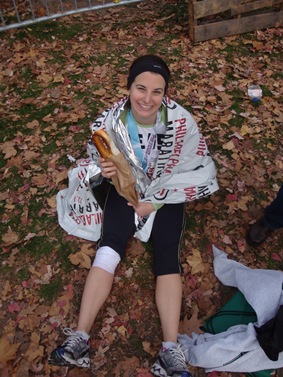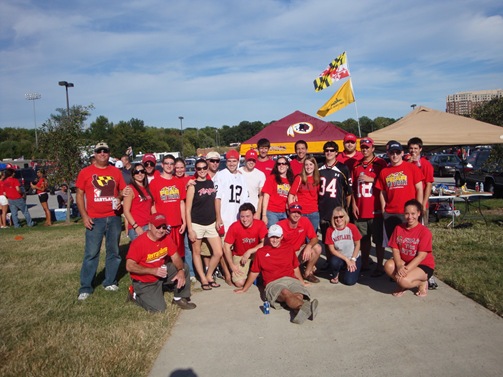In case you’re new to my blog, each Wednesday I feature a different readers journey to find balance during marathon training. While marathons are sweaty, hard work, and a little bit crazy, they also can be a great amount of fun, bonding time with other running friends, and the most amazing feeling to finally accomplish. Today’s post, the 9th in the series, comes from my very first blog friend who also happened to be my first friend in New York City when I moved here 2 years ago: Melissa from FitnessNYC. In fact, this picture was taken weeks after I moved to New York!
 Hi, I’m Melissa from FitnessNYC! Today I am honored to be my good pal Ashley’s featured Marathon and Moderation guest poster.!
Hi, I’m Melissa from FitnessNYC! Today I am honored to be my good pal Ashley’s featured Marathon and Moderation guest poster.!
“Everything in moderation, nothing in excess,” Socrates old adage seems to be a good rule of thumb for running. More isn’t always more when it comes to mileage and stress on your body. Okay, there are some people who seem to be able to run dozens of miles a day without rest, but we can’t all be Dean Karnanzes or Skinny Runner. 🙂
I am now in the early stages of training for my third marathon, and my approach has in many ways come full circle. I have the same coach as when I trained for my first marathon with TNT and his message is still the same: BEHAVE. Behave is often at the beginning and end of every ACS practice and weekly email we receive. It can be interpreted in many ways, but most importantly it means, stick to the training plan, trust the training plan, don’t try to be a hero. Of course, it also implies don’t stay out until 3AM drinking Skinnygirl Margaritas the night before your long run, but I don’t imagine that’s not where most athletes get into troubles, I would guess it’s generally it’s too much too soon or too hard.
 My First Marathon: an Obedient Pupil
My First Marathon: an Obedient Pupil
When I started out as a beginning marathoner, 3 days of running a week were suggested. This plan is pretty foolproof for TNTers; they have 100% success rate for getting first time marathoners across the finish line. Unfortunately, they can’t guarantee quite so high a percentage for second time marathoners, who tend to get cocky and go above and beyond the recommended 3-4 days of running a week and pile on mileage too quickly. In other words, they don’t behave.
I am no exception to this story. For my first marathon, I stuck to the plan and I trusted the plan. On race day I had no doubt I would finish, although I knew it wouldn’t be easy. I had added roughly a mile to each of my long runs until I reached 20 miles and then it was (finally) time to taper. Finishing the Nike Women’s marathon changed my life, it allowed me to achieve what I was sure was impossible.
 Second Time Around: Misbehaving
Second Time Around: Misbehaving
My second marathon training started a bit late as I spent most of July in South Africa. When I started training I was at a base of 4-5 miles. As I moved into long runs, I was shocked to see how easily my endurance was coming back. Within a few weeks of training I was up to around 10 miles and a couple weeks later, 15 miles. While I don’t necessarily believe the 10% rule is the holy grail of training principles, there was no need for me to pile on mileages so fast. But at the time, I was worried about being behind in training and I felt invincible during that first month of running. If it feels great, why not keep going?
Here’s Why Not
About five weeks before the marathon, I suddenly started getting an incredibly sharp pain in the top and bottom of my foot, it was so much I couldn’t even run (or limp) 4 miles on it. I panicked. I was certain my osteopenia had caught up with me and I had a stress fracture. I thought I would never run again. My marathon aspirations were shattered. Fortunately, I saw a great running injury doctor, who diagnosed me with tendonitis and plantar fascittis. He gave me some exercises to do, helped me create a training plan that would get through the marathon, and suggested generous doses of ibuprofen for added insurance. This is not a totally train wreck of a running story; I am not going to lie, the NYC Marathon 2009 turned out to be an amazing race. I enjoyed every moment pain free. However, the weeks of emotions stress, devastation, and icing probably wouldn’t have occurred at all if I had been wise enough to follow the plan I created and add weekly and long run mileage gradually.
 Older and Wiser
Older and Wiser
Third time’s the charm and this time I am sticking to my coach’s plan. I am making sure to get in my runs during the week as well as my long runs—in the suggested distances. As an intermediate, I concentrate a bit more on speed work than I did my first time around, which will hopefully mean a marathon PR. Honestly, 3-4 days of running a week suits me perfectly; it allows me to continue to enjoy other forms of exercise, such as barre classes and spinning and prevents me from getting bored of running. While I did focus on nutrition a lot during my first marathon, I was often nervous about consuming too many calories before, during and after running and while I made it through the training seemingly well fueled; nowadays I always make sure to pack some extra fuel on long runs days just in case I need it. Running is one of the things that makes me realize that feeling strong when you cross a finish line is a much greater accomplishment than reaching a number on a scale.
So moral of the story: Find a plan, follow your plan, trust your plan and you are 90% of the way to the finish line. 🙂



 Step 2. Identify the most important games. For me, this is always homecoming and a few other big conference games. Plan your short runs or recovery runs on those days.
Step 2. Identify the most important games. For me, this is always homecoming and a few other big conference games. Plan your short runs or recovery runs on those days.





